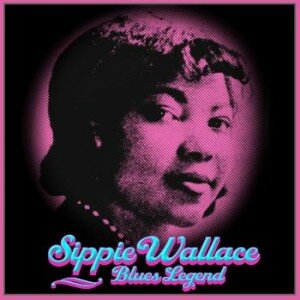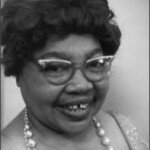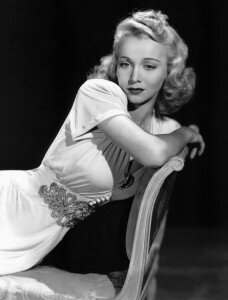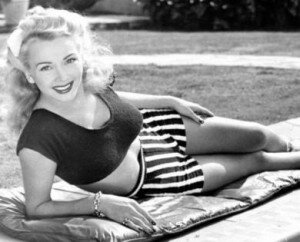By Dixie Laite, on June 23rd, 2014
The thing about hearts that love a lot, they just keep breaking. And this time it’s the ease and energy with which I love a lot of stuff a lot – weird, wonderful stuff – that’s doing me in.
The last vestige of the big weekend Manhattan Flea Market, known as ‘The Garage”, is . . . → Read More: Flea-Smitten
By Dixie Laite, on March 6th, 2014
I learned about blow jobs from Charlie Chaplin. (Yes, that Charlie Chaplin.) I was about 12 and with my babysitting earnings I bought the book Hollywood Babylon. As a passionate old movie fan, and an adolescent girl with a filthy mind and an even filthier curiosity, a book like Hollywood Babylon was a dream . . . → Read More: Mary Astor and Her Dirty Diary
By Dixie Laite, on February 28th, 2014
 According to F. Scott Fitzgerald, “there are no second acts in American lives.” Clearly, F. didn’t know f—, and he certainly didn’t know 1920s Blues singer and writer, “Sippie” Wallace. According to F. Scott Fitzgerald, “there are no second acts in American lives.” Clearly, F. didn’t know f—, and he certainly didn’t know 1920s Blues singer and writer, “Sippie” Wallace.
Like the more well-known Bessie Smith and Ma Rainey, Sippie Wallace was one of the most popular ladies who sang the Blues — in an era and genre in which women routinely outsold their male counterparts. Her career spanned seven decades and had a significant impact on two distinct blues movements separated by half a century. She was also unique among the ladies who sang the blues as she wrote her own lyrics, giving a voice to the female experience in more ways than one. “There isn’t anything I sing about that hasn’t happened to me,” said Sippie, the author of such songs as “After I Was Loved My Eyes Flew Open Like an Electric Light”. Almost a century ago, Wallace sang about things that wouldn’t be discussed at American dinner tables until Monica Lewinsky hobbled on to the scene.
Most people I meet aren’t aware that things were not so prim and proper back in the day. Take just a couple of Blues songs, like Cleo Gibson’s “I’ve Got Ford Engine Movements in My Hips”; “I Let My Daddy Do THAT” by Hattie Hart; Margaret Carter’s understandable plea, “I Want Plenty Grease in My Frying Pan”; and Clara Smith’s lament, “Ain’t Got Nobody to Grind My Coffee”. (We’ve all been there.) Hell, as a teen back in the permissive 70s I was actually shocked when I heard Al Miller’s tragic tale of woe, “I Found Your Keyhole Baby (But My Key Just Won’t Go In)”. And when it comes to dames, they don’t get much dame-er – or game-er – than Sippie.
Beulah “Sippie” Thomas was one of 13 (yikes!) children, born November 1, 1898 in Plum Bayou, Arkansas – a place no doubt whose name sounds much more pleasantly pastoral than the reality. (Coincidentally, eighty-eight years later she died on November 1st as well.) Beulah got her nickname because she had almost no teeth until she was 3 and had to sip everything she ate. When she was still a child, the Thomases moved their weary loins and big brood to Houston where Sippie sang and played piano in the church where her father was deacon. But like many preachers’ children before them, in the evenings the children would sneak out to tent shows. By her mid-teens, Sippie and her brothers Hersal and George were playing and singing the Blues in tent shows throughout Texas
Sippie got herself a solid following, and in 1915 she and George moved to New Orleans. (By the way, what’s the most dangerous thing to be? One of Sippie’s brothers! Hersal died of food poisoning at the tender age of sixteen, while George would die after being hit by a streetcar.) Two years later the woman who penned the ditty “A Man for Every Day of the Week” got married to Matt Wallace.
While in New Orleans Mrs. Wallace met Jazz giants like and ,who were friends of her brother George. Before long Sippie went on the road and was in great demand as “The Texas Nightingale” on the Theater Owners Booking Association black vaudeville circuit. (Its acronym, TOBA, had performers describing it as “Tough on Black Asses.”)
In 1923 she went to Chicago’s toddlin’ town and began performing in the cafes and cabarets. In 1923 she became an overnight success when she recorded her first record, “Up the Country”, which sold more than 100,000 copies in the first three months. Sippie went on to record over forty songs between 1923 -29. In addition to her great women-centric lyrics, her records featured her pals who just happened to be the era’s best jazz musicians; in addition to King and “, her sidemen included people like , and .
The bona fide Blues star’s most popular recordings included “Special Delivery Blues” with Louis Armstrong, “Bedroom Blues” (written by George and Hersal Thomas), “I’m So Glad I’m a Brownskin”,“Mighty Tight Woman” and arguably her most famous tune, “Women Be Wise” – a warning about keeping your mouth shut when it comes to your man’s bedroom prowess.

Adorable, right?
Successful as she was, in 1929 Sippie moved to Detroit and left show business in the early 1930s when the Blues craze died down, as did several relatives. She got religion and stopped doing secular music, concentrating on church music. But thirty-some years later Sippie had her Fitzgerald-poo-pooed second act. She launched a comeback in 1966 with fellow Texan and longtime friend, . She followed up an album with Spivey with Sippie Wallace Sings the Blues and Women Be Wise.
But, just as things were looking up, Sippie suffered a massive stroke in 1969. “It was six months before she could walk or talk,” recalled her manager, “but the first thing she did was to play the piano.” This Blues badass was not about to let a little thing like that stop her. “If I was in the middle of dying,” said Wallace, “and someone said, ‘Sippie, sing me a song,’ I’d stop dying to sing that song.” She was still in a wheelchair in 1972 when popular singer-guitarist Bonnie Raitt heard of her idol’s recovery and urged that she be invited to perform at the Ann Arbor Blues and Jazz Festival.
After majoring in African studies at Radcliffe, Bonnie Raitt had become a fixture on the folk/blues scene in Cambridge coffeehouses. In 1968, an album in a London record store featuring a photo of Sippie caught Bonnie’s eye. “I saw the rhinestone glasses and the tiger-striped vest and said to myself, ‘This woman really knows how to dress.’” (I would have fallen in love with her in that outfit, too. I get girl crushy feelings just thinking about it.) The two women met and really hit it off, culminating in the trans-generational soul sisters’ duet on Sippie’s Women Be Wise. In 1971 Bonnie recorded her own rendition of “Women Be Wise” and Wallace toured and recorded with her throughout the 1970s and 1980s, while also performing on her own. Bonnie helped Sippie score a recording deal with Atlantic Records and recorded an eponymous album that featured Raitt and was nominated for a Grammy in 1983 and won a W.C. Handy Award for “Best Blues Album” in 1984.
Bonnie really related to her friend’s twin love of music…and men. “Sippie has always seen the struggle of the sexes with a sense of humor and compassion,” explained Bonnie. “She knows that freedom is the name of the game even though women have always had to answer to men.”
Sippie died on November 1st 1986, but her legacy lives on. Thanks to Ms. Wallace, millions of women like me know not to “Advertise our man” and are far better off for it. Continue reading Sippie Wallace: A Mighty Tight Woman
By Dixie Laite, on February 13th, 2014
 Carole Landis is known primarily as the bosomy blonde movie star who offed herself over Rex Harrison. Of all the schmucks who’ve driven ladies to leap, the idea of killing yourself over a tool like “Sexy Rexy” seems especially senseless. But in Hollywood’s Golden Years one of filmdom’s most glamorous and popular stars did indeed end her life over that Doolittle douche. Carole Landis is known primarily as the bosomy blonde movie star who offed herself over Rex Harrison. Of all the schmucks who’ve driven ladies to leap, the idea of killing yourself over a tool like “Sexy Rexy” seems especially senseless. But in Hollywood’s Golden Years one of filmdom’s most glamorous and popular stars did indeed end her life over that Doolittle douche.
Today not many people have heard of Carole Landis, but her story is one of Hollywood’s most fascinating tales, with more twists and turns than her enviable curves.
Carole’s story begins in Midwestern Gothic luridness with a steady stream of heartbreaking details that make you periodically have to stop reading and go, “Seriously?!”, then sigh and warily dip in for more.
She was born Frances Ridste on New Year’s Day in 1919 in the aptly named burg of Fairchild, Wisconsin, to a farmer’s daughter and a “drifting railroad mechanic” who’d already abandoned the family before little Carole came along. (The “drifting railroad mechanic” wasn’t a stable family man? Quelle surprise!) Her mother was no saint either; Charles Fenner, her second husband, and the man with whom she’d been having an adulterous affair, was most likely Landis’s biological father. The youngest of five children, two of whom died in childhood, her early years were filled with poverty and sexual abuse.
Carole was such a beautiful infant she earned the nickname “Baby Doll”. According to family sources, she was sexually molested by a relative for much of her childhood. Given young Baby Doll’s shitty start in life, it’s no surprise that Carole 1) seemed much older than her years, and 2) was interested in being in show biz. Little Carole covered her walls with photos cut from magazines of movie stars like Mary Astor and Clark Gable. At age nine, little Carole ran up on stage during a local talent show and started to sing. Using make-up tricks to hide her age, she started entering beauty pageants at the tender age of twelve! (She won a pair of silk stockings and an electric heater. Who says beauty can’t buy you anything?)
In high school Landis often skipped class – “boy crazy ” was the general consensus. “I always seemed so much older than the other kids my age,” said Carole, “They seemed like tots.”
She was ahead of her classmates and ahead of her time. As a teenager she tried to form an all female football team at school, but the principal stopped her because it was “unladylike”. It’s not surprising that Carole dropped out of high school at 15 to get her whole show biz thing underway. She worked as a hula dancer in a San Francisco nightclub, she sang with a dance band, and she worked at a hamburger stand, a department store, a movie theater. She dyed her hair blonde and changed her name to “Carole Landis” after her favorite actress, Carole Lombard. She eventually saved up $100 and hightailed it to Hollywood.

The Ping Girl
Her 1937 film debut was as an extra in the original film version of A Star Is Born. Next she found herself in various horse operas and an untold number of cheesecake photos. Eventually her cheesecakery paid off big; in 1940 studio head Hal Roach cast her as a scantily-clad cave girl in the original film version of One Million B.C.. Just as it would for Raquel Welch a quarter-century later, the movie made Landis a star. Soon, just as Clara Bow had been dubbed the “It Girl” and Ann Sheridan was crowned the “Oomph Girl”, publicists gave Carole the title the “Ping Girl.”
The Ping Girl moniker was attributed to a take-off on the popular motor oil ad at the time that claimed to take the ‘ping’ out of an engine and “make it purr”.
Some claimed it was a mash-up of PIN-up Girl. Some say it alludes to Carole’s erection-generating abilities, as in “I saw her and –ping!” Miss Hard-On of 1940 may have very well been aware of this etymology; once in an interview Landis said ‘ping’ was a term in Hollywood slang, but neglected to mention for what.
Most interesting to me about the whole “Ping Girl” thing was how brilliantly Carole (or possibly her PR folks) leveraged being against the sobriquet:
“I want a fair chance to prove myself something more than a curvaceous cutie. I want to get out of bathing suits and into something more substantial. Unfortunately the publicity department of my studio does not agree. They have conceived the brilliant idea of selling me to the public as ‘the Ping Girl’. This flash of genius is to be illustrated with a series of pictures out of their files, suggestive of anything but acting talent.”
Still, Landis was well aware that being pin-uppity had been her ticket to the big time:
“Leg art did the trick — naughty leg art, if you happen to look at it in that light. When the boys needed someone to pose in a skin-tight white bathing suit, go sleigh riding in shorts, or climb a ladder in a skirt, they’d yell, ‘Get Landis!’ That made everybody happy except, maybe, the goody-goods and the bluenoses, and I suspect they took a second peek now and then.”
Like a lot of women, Carole had a lot of ambivalence about using her assets to get ahead. She posed for cheesecake photos by the thousands, but then resented all the attention they garnered.
“Heaven knows I want people to think I have sex appeal. But I also want to think I have something besides sex appeal.”
God knows Carole was a smart cookie in every sense of the word. She loved to read, and was a fan of Ernest Hemingway, Noel Coward, and W. Somerset Maugham. (Hemingway gifted her with a set of personally autographed books.) But it was Landis’s more physical charms that got her places, both on and off-screen. She scored a contract with Twentieth-Century Fox, and was involved with studio head Darryl Zanuck, though it’s not entirely clear to me which came first, the chicken or the egg. She was in a series of successful films, playing second fiddle to Betty Grable in I Wake Up Screaming and Moon Over Miami. But she lost a pivotal role that ended up thrusting Rita Hayworth into stardom in the soapy bullfighter pic, Blood and Sand — very likely because she ended her affair with Zanuck. In fact, her ditching Darryl got her relegated to B pictures at the studio from then on. Continue reading The Scandalous Suicide of Hollywood’s Carole Landis
By Dixie Laite, on February 8th, 2014

The public debate surrounding Dylan Farrow-Woody Allen has kept me up nights. I’ve been immobilized by sadness, anger, and shame.
For 40 years I’ve been terrified to write about this, and 40 years is a long time to be terrified. But now, maybe it’s been long enough. Both my parents are dead now. And . . . → Read More: Down There: Woody Allen, Dylan Farrow and Me
STILL Hot For Teacher
By Dixie Laite, on January 23rd, 2014
My first love is dead.
Like millions of girls (and undoubtedly quite a few boys) growing up in the 60s, my first crush was on Russell Johnson, who played Roy Hinkley, known to generations of TV viewers simply as The Professor.
The One-Track Minded Professor
I imagined being held in his arms, smelling . . . → Read More: STILL Hot For Teacher
By Dixie Laite, on November 13th, 2013

Lily Allen’s new video for Hard Out Here got me thinking.
My first thought was that it’s great when a mainstream female artist draws attention to sexism, misogyny and double standards. My second thought was that I wish the message wasn’t accompanied by (lots of) the very porn-y and corny imagery it professes to . . . → Read More: Lily’s Right, It IS Hard Out Here
By Dixie Laite, on October 28th, 2013

I have a feeling we’re not in Kansas anymore.
What should I be for Halloween this year? A sexy vampire, a sexy astronaut, a sexy nurse, a sexy pirate, a sexy carrot – the possibilities are endless.
When I was a little girl, like all children I Imagined who I’d like to be . . . → Read More: Halloween Costumes, Pop Tarts and Candy Porn
Marie Prevost : The Movie Star Eaten By Her Dog (Or Was She?)
By Dixie Laite, on September 4th, 2013

“She was a winner, Who became a doggie’s dinner…” — Nick Lowe
Would a dog loving movie star leave her pooch to starve?
Memorialized in Kenneth Anger’s Hollywood Babylon and in the eponymous pop song, Marie Prevost is best-known today as a overly-nasal actress who killed herself without anticipating that her pet . . . → Read More: Marie Prevost – The Movie Star Eaten By Her Dog (Or Was She?)
By Dixie Laite, on August 26th, 2013
Everybody, let’s stop with the slut-shaming. Her performance at the VMAs is upsetting, but not for the reasons you think. The furor and shock and vitriol strike me as the height of hypocrisy and sexism.
Miley Cyrus is still America’s Sweetheart — the REAL America
Am I happy young girls feel they need . . . → Read More: In Defense of Miley Cyrus
|
|

 According to F. Scott Fitzgerald, “there are no second acts in American lives.” Clearly, F. didn’t know f—, and he certainly didn’t know 1920s Blues singer and writer, “Sippie” Wallace.
According to F. Scott Fitzgerald, “there are no second acts in American lives.” Clearly, F. didn’t know f—, and he certainly didn’t know 1920s Blues singer and writer, “Sippie” Wallace.


 Carole Landis is known primarily as the bosomy blonde movie star who offed herself over Rex Harrison. Of all the schmucks who’ve driven ladies to leap, the idea of killing yourself over a tool like “Sexy Rexy” seems especially senseless. But in Hollywood’s Golden Years one of filmdom’s most glamorous and popular stars did indeed end her life over that Doolittle douche.
Carole Landis is known primarily as the bosomy blonde movie star who offed herself over Rex Harrison. Of all the schmucks who’ve driven ladies to leap, the idea of killing yourself over a tool like “Sexy Rexy” seems especially senseless. But in Hollywood’s Golden Years one of filmdom’s most glamorous and popular stars did indeed end her life over that Doolittle douche.









